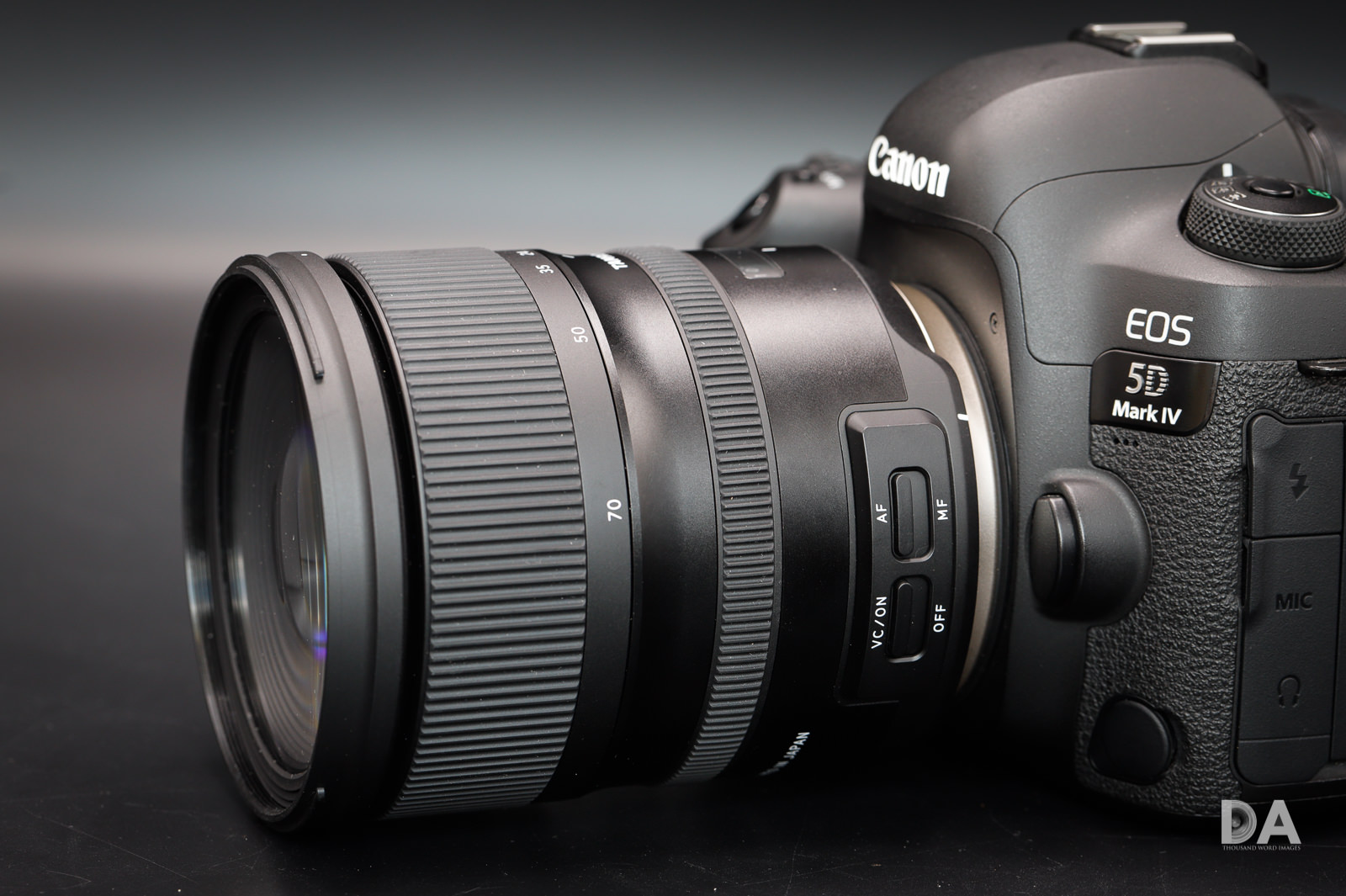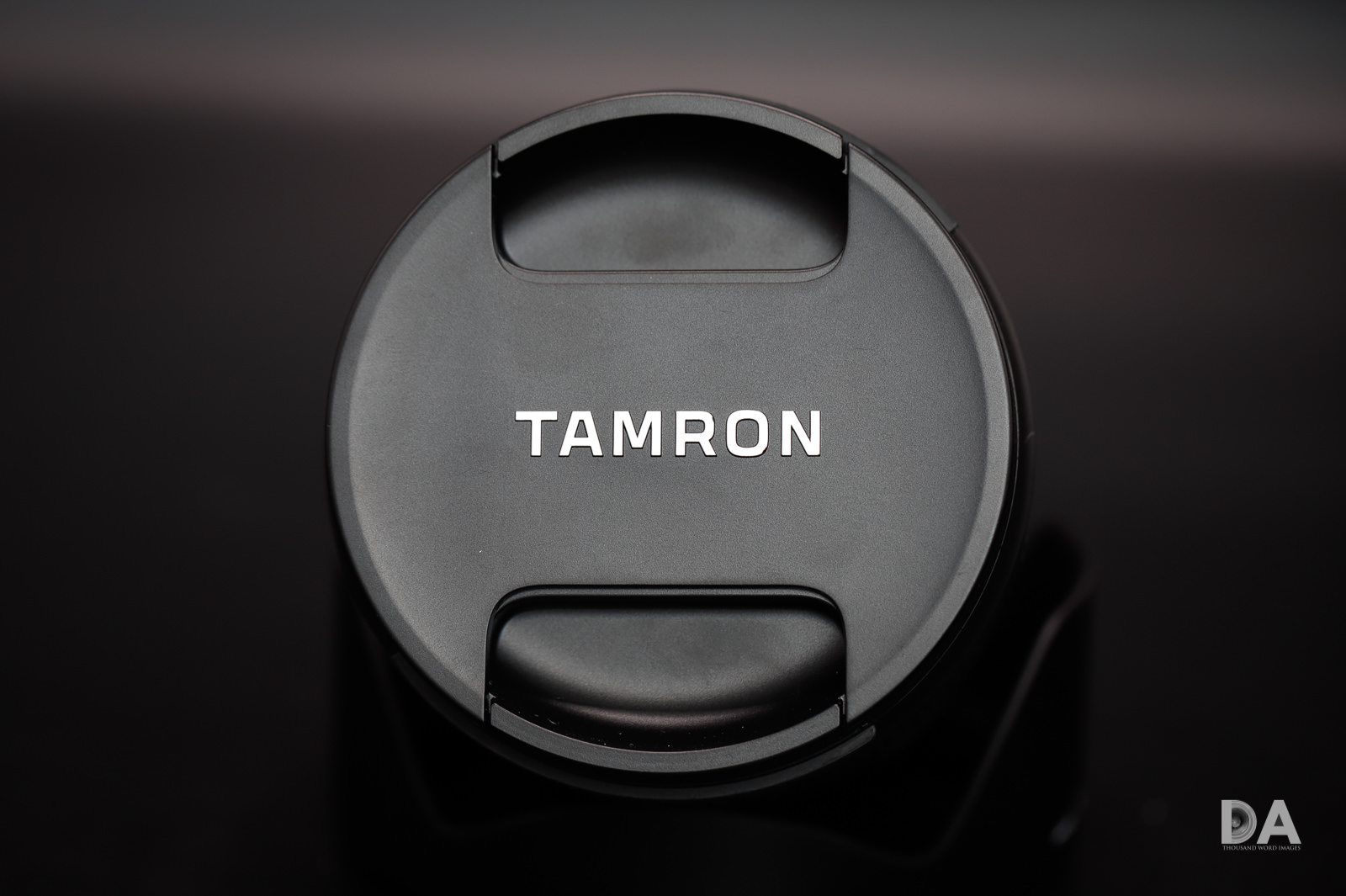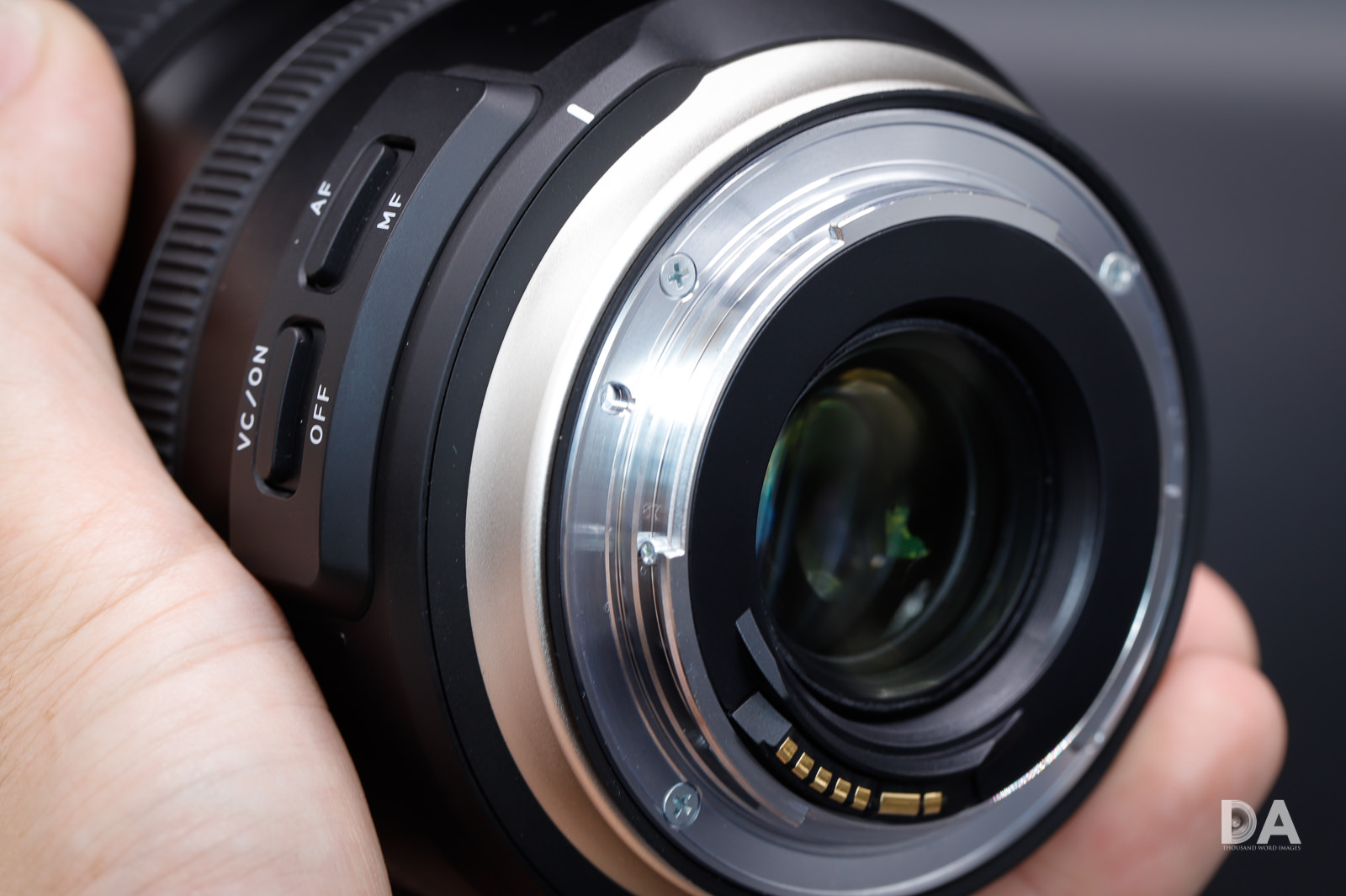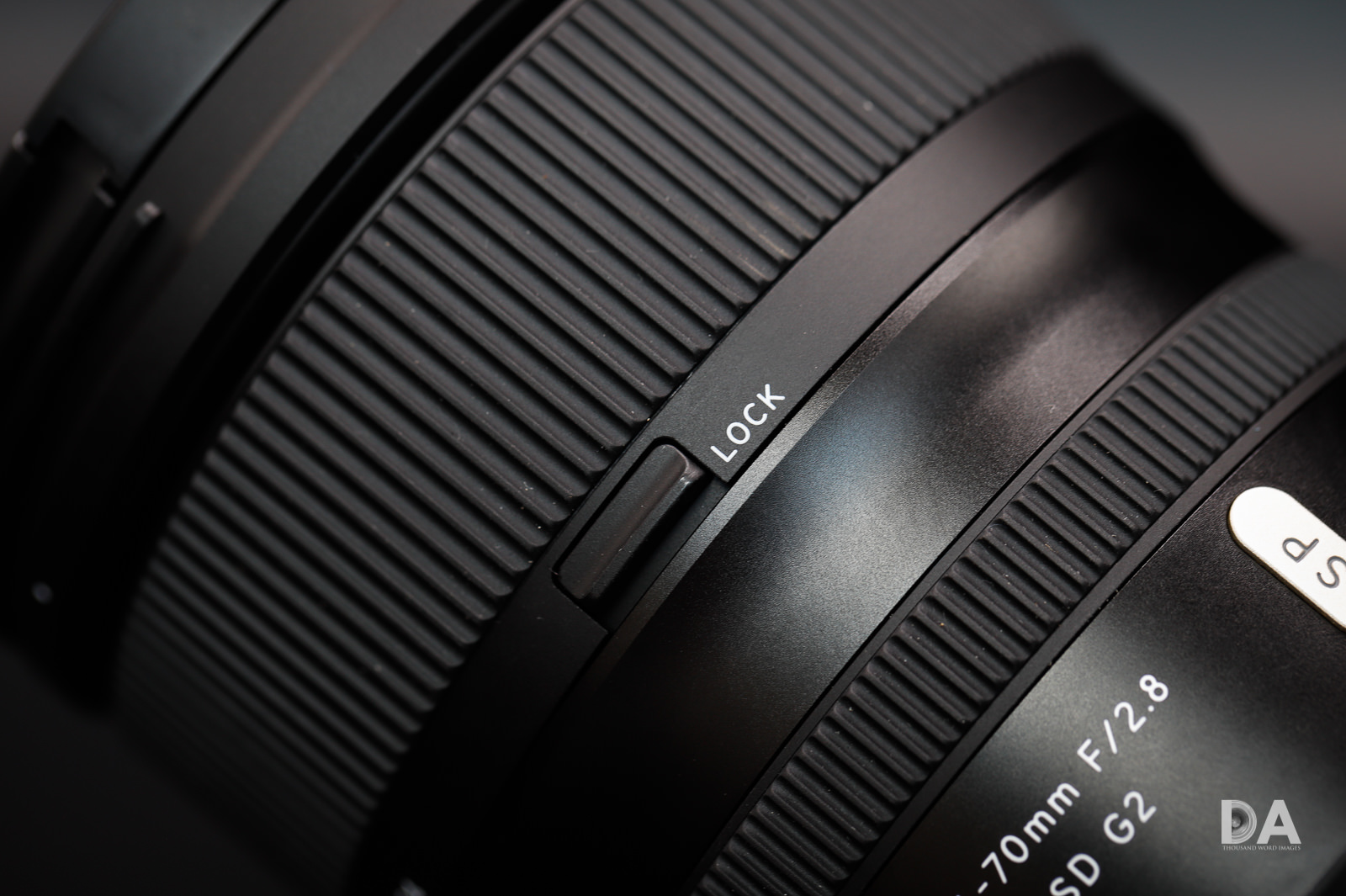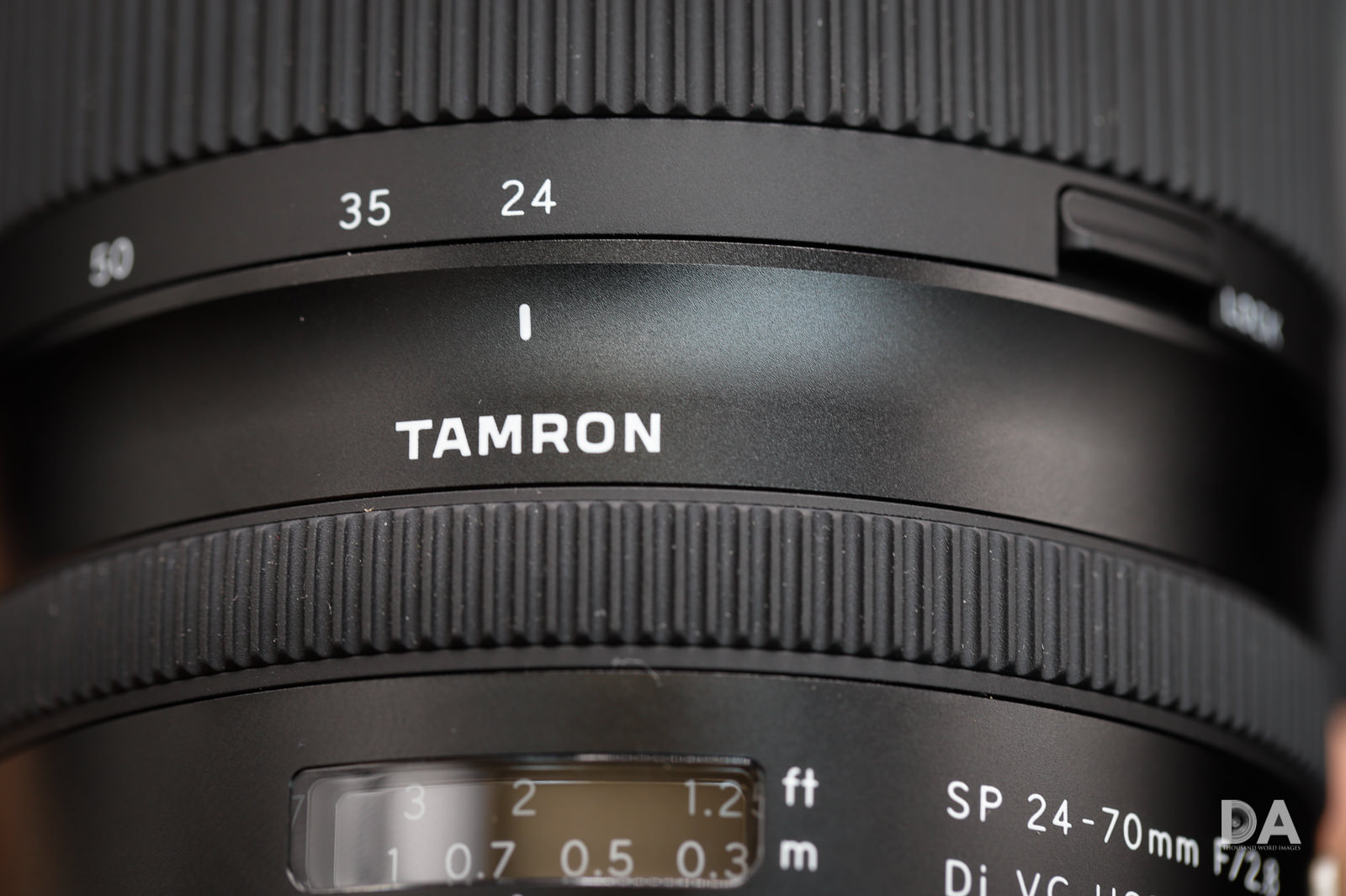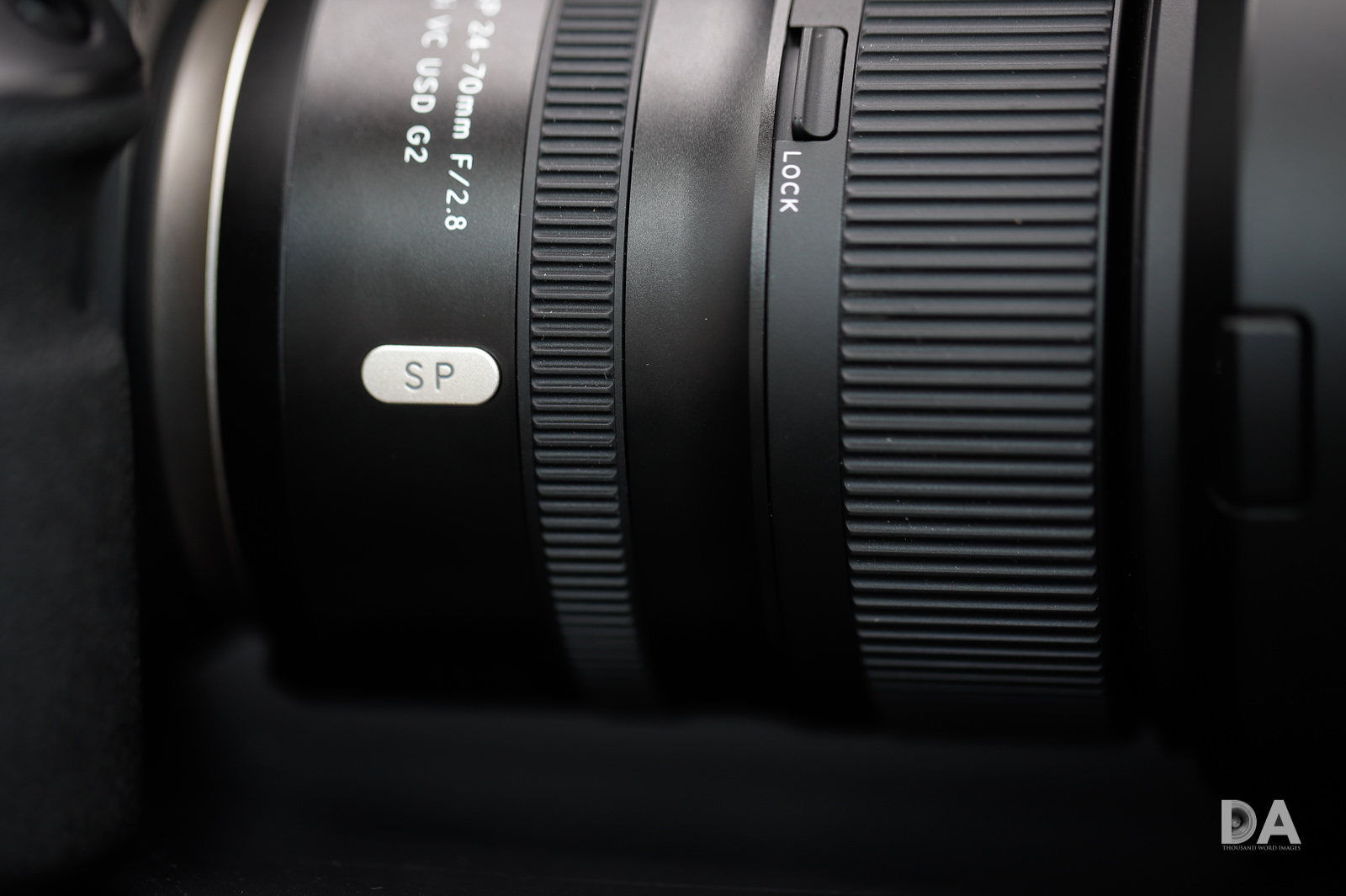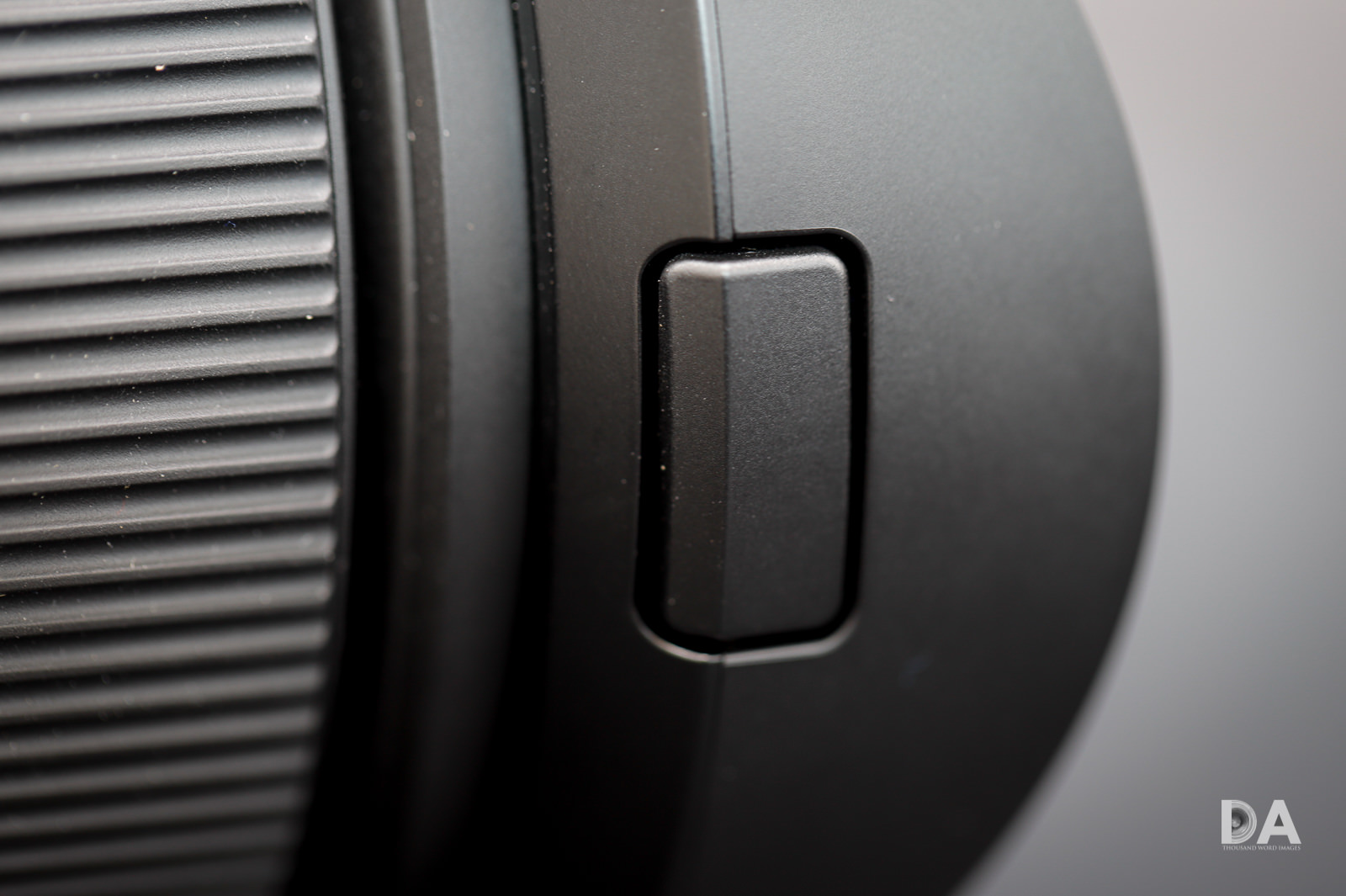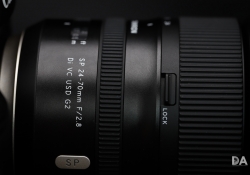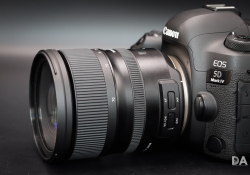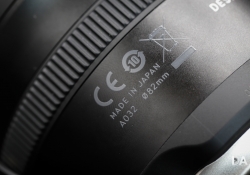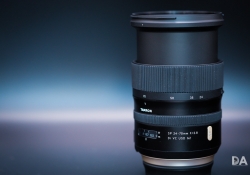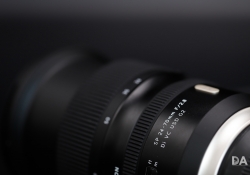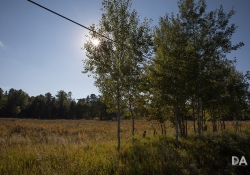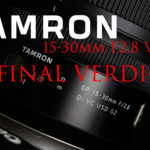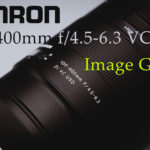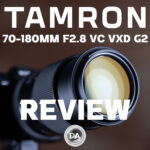There are few lenses more important to a lens makers lineup than the 24-70mm f/2.8 lens. A 24-70mm is valued because of the versatility of its zoom range, which covers a number of very important focal lengths, including 24mm, 28mm, 35mm, 50mm, and 70mm. All of these (save perhaps 70mm), are focal lengths that prime lenses are sold in, and the reasonably wide aperture of f/2.8 means that photographers can still that shallow depth of field “pro look” to their shots for events and weddings. I personally have most often used a combination of a 24-70mm f/2.8 and 70-200mm f/2.8 zoom lenses to shoot weddings and events. Tamron was the very first to come to market with a stabilized 24-70mm f/2.8 lens (the SP 24-70mm f/2.8 VC USD), and it could be effectively argued that it was that lens that really launched their recent renaissance as a maker of serious, professional grade lenses. Now, some five years later, Tamron has delivered their second generation stabilized 24-70mm f/2.8 zoom – the Tamron SP 24-70mm f/2.8 Di VC USD G2 – and the progress of the past five years shows in essentially every detail of the 24-70 G2.
I will confess to having a bit of a soft spot for the original 24-70mm VC lens. It was the first of my major reviews, and it was on the strength of that review that I began to have conversations with retailers and distributors about loaning me lenses. I had purchased a copy of that lens, and used it for over 4 years on multiple continents and for more than 15,000 photos. It served me well, and paid for itself many times over in commercial work. I thought it was a highly competitive lens in a lot of ways, but it did have a few notable weaknesses. Most often criticized was the slowish autofocus speed, some “onion bokeh” (concentric rings in specular highlights), and a few quirks in the VC (Vibration Compensation) image stabilization system. But when I began to evaluate the 24-70 G2, it became very clear that Tamron has strongly benefitted from being the first to come to the market with a stabilized 24-70mm f/2.8 lens, as the G2 version shows all the signs of being a more polished, mature lens than the competition. If you want a quick take on the lens, you can check out the review I wrote for PhotoNews Magazine here.
Prefer to watch your reviews? Click the video below to see my full video review.
Build Quality
Comparing the two generations of Tamron’s 24-70mm lenses side by side reveals just how much Tamron’s design philosophy has matured (which also shows the maturity of Tamron as a company). The “G1” (A007) looks pretty dated when set side by side with the G2 (A032), which is less a knock on the older lens and more a compliment to the decidedly more upscale look that recent Tamron lens have adopted. Materials are improved, the design philosophy has a clean, modern look, and the handling is excellent. I encourage you to watch this video to see an interactive look at the design and materials of the lens:
Even the newer Tamron front and rear caps are among my favorites from any lens maker. The pinch mechanism on the front caps have a nicer movement than others, and the cap itself feels substantive rather than flimsy.
Tamron has moved to a metal (aluminum alloy) for the body materials of its pro-grade lenses, which results in a nice balance between durability, feel, and weight. That’s not to say that the lens hasn’t put on some weight. The A007 lens (G1) weighed 29.1 oz (825g), while the new A032 (G2) lens now weighs 31.8 oz (904g). This is definitely heavier than the Canon 24-70mm f/2.8L II (805g) but significantly lighter than the Sigma 24-70mm f/2.8 ART (1020g). The Sigma comes across as being unnecessarily heavy, particularly when one considers that it employs less metal in the housing and doesn’t surpass the others in sharpness. The Canon 24-70mm f/2.8L II comes in at just over 800g, so it is the lightest of the bunch. The additional weight of the G2 over the G1 lens seems appropriate when you feel the huge improvement in materials (not to mention additional functionality in the autofocus and VC systems). For practical purposes, it doesn’t really feel any heavier to me, either.
Tamron has also improved the quality of the weather sealing, with more internal seals along with a fluorine coating on the front element to make it more resistant to oil and moisture (which has the added benefit of making it easier to clean). The rise of fluorine coatings on front elements has made me (personally) less inclined towards adding protective filters on such lenses, which allows the lens to perform more optimally. My observation over the years is that a good UV filter doesn’t negatively impact image quality (nor does it improve it), but I have noted a greater likelihood of flare and ghosting when the sun is in the frame. It is primarily for this reason (since I like to backlight!) that I prefer the bare lens…if I feel it is suitably protected by a lens hood and quality coatings.
While the handling of the new Tamron and Sigma lenses is more similar than different, there is one definite area where I favor the Tamron design. Both lenses feature a fairly narrow manual focus ring, but the Sigma’s has only a few millimeters of separation from the wider zoom ring with only a flush smooth surface in between. As a result, it is fairly easy to inadvertently hit the other ring when trying to move the opposite ring. The Tamron has a slightly wider amount of separation, but, more importantly, there is a flaring of the barrel from the focus ring to the zoom ring, putting both on different planes and making inadvertent touches far less likely. This tapered area between also becomes a nice place to support the lens, with a nice ergonomic feel. My least favorite part of the Canon 24-70L II design is when trying to dismount the lens; the zoom ring begins right after the lens mount, leaving one without a natural place to grip and twist the lens off the lens mount.
The Tamron zooms in and out smoothly, with a nice amount of resistance (damping). The manual focus ring is fine but unexceptional. Full time manual override is available, but there is only about 115 degrees of focus throw, so this is not a lens designed around manual focus. There is a distance window that does help with manual focus.
The zoom ring moves in the “Nikon” direction (to the right), which will continue to irritate some Canon shooters who would prefer that all their lenses zoom in the same direction. This isn’t something that I notice much, myself, but I also use a wide variety of gear all the time so my brain is accustomed to adjusting to little differences in the gear I test. The zoom ring has a nice amount of resistance, and the single barrel extends about 1 ½ inches without wobble, though there is a little bit of a “pump” feel of air being pushed during zoom. This may put the dust resistance to the test.
The 24-70 G2 is listed as being 3.48”/88.4mm (Diameter) and 4.4”/111.8mm in length, while the Sigma 24-70 ART is listed at 3.5”/88mm (Diameter) and 4.24”/107.6mm in length. There’s something a little off in those specs, however, as a quick visual inspection confirms that the Tamron is a little longer, but when measuring the girth of the two lenses I found confirmation of something else I visually confirmed: the Sigma is definitely the thicker of the two lenses, measuring a half centimeter wider around (5mm). The Tamron appears longer and slimmer, and the Sigma appears shorter and squatter. My own measurements confirm this.
The 24-70 G2 shows no inclination towards zoom creep, but, just in case, it does have a nicely designed zoom lock switch (something the Sigma lacks). The two switches on the barrel (AF/MF and VC ON/OFF) are in a raised section, but the switches themselves are low profile to avoid any accidental engagement. Both the Sigma and Tamron lenses share an 82mm front filter thread, though the Tamron employs metal rather than plastic threads (the jury is still out on which is actually more durable over the long haul, though metal certainly seems more premium). There are nine rounded aperture blades, and both Canon and Nikon mounts receive full electromagnetic diaphragm control.
Tamron has employed a locking mechanism on the lens hood for the first time. While I’m not entirely convinced that locking mechanisms on hoods are really required if the hood is well engineered, but I will note that I vastly prefer Tamron’s lock to Canon’s, as the Canon’s lock button is quite small and requires a pointed finger to engage it, while Tamron’s is about twice as wide and easy to depress even with a thumb. I find depressing it and releasing the hood a more natural ergonomic movement than on any of the Canon models I have that employ a lock mechanism.
It is also worth noting that the two switches are very nicely engineered and low profile to avoid accidental engagement. They move with a very precise, definite click. The two switches are for AF/MF (full time manual override is always available) and ON/OFF for the VC system (more options for the VC can be programmed through the Tap In Console).
The 24-70 G2 is a beautifully built lens that feels very professional grade. The two copies I reviewed (one sourced from the USA, the other from Canada) both noted that they were made in Japan (other than the lens hood, which is made in the Philippines). I think that most photographers save those Canon shooters who despise the “opposite” rotation (the contrarian argument is that everyone save Canon focuses and zooms in that direction) will be delighted with the build and handling of the lens. It seems decades newer rather than only five years newer than the G1 lens. It is worth noting that the Canon 24-105L II that I had on hand at the same time seems noticeably cheaper and more “plasticky” by comparison. The Canon 24-70L II is a tried and tested lens, but the Tamron looks and feels higher grade in terms of materials.
24-70 G2 Vibration Compensation Performance
One of the chief knocks against the previous generation A007 lens was that while it was the first stabilized 24-70mm f/2.8 lens, the stabilization was less than optimal. It offered around three stops of stability, but more objectionable was the fact that it could be a little “jerky” when turning on/off, sometimes shifting the viewfinder image a bit. It also didn’t work exceptionally well for video, which, of course, is one of the chief reasons for buying a stabilized zoom lens. Finally, it was a bit slow to engage, so to get the best performance out it required one to be a bit more deliberate in shooting. You needed to give it a second or two to fully engage before taking the shot to reap the benefits.
I was reminded of this while performing a test of the stabilization systems on a few lenses. I was doing a real-world test, where one would bring the camera up for the shot, focus, and quickly shoot. I would encourage you to watch this video to see the test itself along with other measures of lens’ performance.
For this type of test, and with those types of shutter speeds (1/15th, 1/10, and 1/6th second), the VC on the A007 was next to useless. Tamron clearly wanted to address this in the second generation, and this statement was made in the press release: “The new A032 is equipped with Tamron’s proprietary VC (Vibration Compensation) system. Adding an MPU dedicated to VC processing unleashes a new-generation algorithm, ensuring the highest vibration compensation ability in the class (CIPA level of 5 stops). Even in low light or with slow shutter speeds, photographers can enjoy shake-free handheld shooting with ease and comfort.”
It should be noted that achieving the best performance from the VC system for Tamron’s recent releases requires using the Tap In Console and selecting “Capture Priority” mode. Capture Priority mode emphasizes stabilizing the actual photo over trying to stabilize the viewfinder. Those with shaky hands that feel the shake negatively impacts their actual composing should leave the lens in the standard mode, as this still provides the best stabilization of any of the three competitors I tested (Sigma OS ART, G1, and G2 lenses).
Here’s crops from each lens to show consistency in results, first at 1/15th second shutter speed (all tests were done at 70mm):
Tamron G2:
Tamron G1:
Sigma ART:
The Canon 24-70mm f/2.8L II I had on hand gets a fail here, as it doesn’t have any stabilization and would just look terrible in this comparison. In this first comparison, the G2 gave slightly more consistent results than the Sigma, and the G1 was a distant third.
Now we will shift to 1/10th of a second shutter speed.
Tamron G2:
Tamron G1:
Sigma ART:
Only the G2 performed well in this comparison. The G1 showed the limitations of its system, and the Sigma’s result was surprising, particularly considering the following:
Comparison at 1/6th second:
Tamron G2:
Tamron G1:
Sigma ART:
Oddly enough the Sigma turned in a much stronger performance at 1/6th than 1/10th. The G1 really struggled at that shutter speed, and the G2 continued its consistent performance, performing in a nicely linear fashion. Still, I thought the Sigma did as well at this shutter speed as the G2. I got by far the greatest consistency out of the G2 lens, which showed its maturity as a second rather than first generation lens. These tests were done with the 24-70 G2 in the standard mode, not Capture Priority, which would render slightly better results. I was able to get some crisp shots at 70mm and shutter speeds as low as 1/6th second. I don’t really find testing beyond those limits to be very practical as the very act of taking the photo creates significant movement. Here’s a 70mm image along with a 24mm image and crop – all at 0.6 second shutter speed.
Video shooters can also program a “Viewfinder Priority” mode that is best suited for video, with emphasis on ongoing smoothness to provide the best footage results. I recommend purchasing a Tap In Console because of the ability to maximize the performance of your lenses along with the ability to quickly apply firmware updates at home and thus ensuring ongoing compatibility with future camera systems.
Beyond the raw performance, however, the 24-70 G2 also provides a smoother VC performance, with quieter operation, smoother transitions on and off, and generally good behavior all around. Tamron’s new policy of assigning a dedicated MPU (processor) to their VC systems definitely pays off with solid performance.
Autofocus Performance
Another area of criticism with the A007 lens five years ago was the fact that it definitely wasn’t as quick to focus as the first party lenses from Canon and Nikon. It needed a split second to “spool up” before the elements began to move, and there was a slight “shtick” sound as they moved. This was a clear sign of a need for a bit more torque in Tamron’s USD (Ultrasonic Drive) AF motor despite it being a true ring-type focus motor. Tamron pledged to address that in the G2 version. This from their press release: “This innovative control system uses a Dual MPU design with enhanced computing capacity. The MPUs have powerful, built-in DSP (Digital Signal Processor) blocks that achieve quicker and more precise AF performance, and more consistently powerful Vibration Compensation. The features combine to provide outstanding performance at night and in low light.”
The language is a bit murky, but what it boils down to is that Tamron has moved to using two separate processors. This has allowed them to not only achieve better VC performance (as previously addressed), but also gives them more processing power for autofocus, which has resulted in more speed and great focus accuracy. The last point deserves an asterisk, however, as I have found that Tamron’s new lenses deliver exceptional autofocus accuracy…IF…you spend the time with the Tap In Console and carefully calibrate them. This can be very time-consuming process (particularly with a zoom lens), as you can calibrate different focal lengths at three different focus distances. It is, frankly, more time that I have to invest in review lenses, though I have done it on enough recent Tamron lenses (I own three Tap In compatible lenses) to verify that one can achieve exceptional results if you make the investment of time. I just did a standard AFMA on the two copies of the 24-70 G2 I used for this review. They both needed a fair amount of calibration (not unusual in my experience), but began to deliver consistent focus results after that calibration. Tamron seems to have done an excellent job of delivering the ability to achieve great focus accuracy for those willing to calibrate them. From what I understand, Tamron’s next goal is to develop lenses that require little calibration at all.
A huge area of improvement is in focus speed. I did a video segment where I covered focus speed (and noise), and found that the 24-70 G2 delivered [very] slightly faster results than the Sigma and hugely faster results than the G1. I would venture that there is now no real first party advantage in terms of focus speed (and even accuracy with a good calibration), which puts more pressure on Canon and Nikon when the G2 undercuts their price by a wide margin (the Canon without stabilization is more than 50% more, while the Nikkor lens with stabilization is more than twice the price). I didn’t notice any difference in focus speed when I compared the Canon 24-70L II and the Tamron in terms of focus speed and confidence in locking focus. That’s a HUGE improvement over where the previous generation Tamron was in this comparison.
The previous generation Tamron was competitive optically (and on price, of course), but the 24-70 G2 is now competitive on every level while still undercutting everyone on price. I predict that this lens will do very, very well for Tamron.
24-70 G2 on Sony
Many modern lenses work quite well on Sony E mount cameras via adapter, and the 24-70 G2 is no different. It focuses well via the Sigma MC-11 adapter, and I got nice looking results. Unfortunately I only have access to Sony APS-C E mount, but the results were pleasing on my Sony a6500. You can see a gallery from this combination here:
When using the MC-11 and the Tamron, there are only two focus modes available (AF-S and AF-C), but focus is actually quite snappy. I don’t know that I would rely on the face tracking in video mode as the tested combination didn’t want to consistently engage AF-C focus during video recording. For stills use, however, this is a nice added bonus, and might be a much more affordable option to some than the very expensive Sony G-Master lens.
Image Quality
It can be hard to judge the image quality of zoom lenses like these in a vacuum, so I brought in a few natural competitors, including the new Sigma 24-70mm f/2.8 OS ART lens that I recently reviewed, the previous generation Tamron 24-70mm f/2.8 VC lens, a Canon EF 24-70mm f/2.8L II, and even a second copy of the 24-70 G2 sourced from a different country (one from Canada; one from the USA). I value having multiple copies of a lens so that I can (at least in a limited sense) test for sample variation. I would encourage you to watch my interactive videos here for a closer look at the images themselves, but I will summarize my findings here.
Resolution Comparisons
First, a few general observations:
- The two copies of the 24-70 G2 were quite consistent. There were a few moments where I felt a comparison favored one or the other, but all in all they were more similar than different. It’s nice to see this kind of consistency.
- The rumor that the G2 just recycled the optics from the first generation is somewhat misleading. When I inquired with some contacts within the Tamron organization, they pointed me to this, “The use of new specialized, high quality glass materials that offer greater optical transmittance are used in the new model A032 to ensure superior color reproduction and even greater sharpness than the previous model. At the same time, the application of Tamron’s exclusive nanotechnology-based eBAND Coating in the new model substantially curbs the ghosting and flare that are prone to occur in backlit photography. Together, the engineers have successfully improved the overall optical performance of the lens.” So, while the optical formula is the same (the number of elements and their placement), better materials and better coatings result in improved performance. In my testing, I found that the “G1” lens had similar performance in the center of the frame at the tested focal lengths, but it clearly lagged behind the G2 lens in corner performance.
- At most focal lengths the Canon EF 24-70mm f/2.8L II has the strongest performance in terms of absolute resolution and microcontrast. There is some give and take with both the Sigma and the Tamron lenses at different focal lengths and spots across the frame, but I give the edge in both sharpness and microcontrast to the Canon.
- At minimum focus distances the Canon and Tamron G2 are roughly equal. The Sigma has a bit more magnification (0.22x vs 0.21x, but doesn’t resolve quite as well):
- Stopped down to f/4 and beyond there is no real difference between the Canon and G2 lenses. There is give and take across the frame but no clear advantage for either lens. This is also true of the Sigma around 50mm, where it is actually the best lens of the bunch.
- The G2 lens is stronger than the Sigma on the wide end and along the edges of the image frame. The Sigma is strongest in the middle of the range (35-50mm), where it slightly edges the Tamron in the center wide open, but either ties it or slightly lags behind it on the edges. The sharpness difference between the lenses is not significant, but what is noticeable, however, is that while the Sigma improves less when stopped down (particularly along the edges), making 24-70 G2 the more effective landscape lens.
- The Tamron demonstrates the best light transmission of any of the options, with the Sigma requiring the most light.
- On the negative side, the 24-70 G2 showed less wide open contrast than any of the options. Stopping down even 1/3rd of a stop to f/3.2 shows a marked improvement. I did a number of side by side comparisons with the lens at f/2.8 and then at f/3.2, and significant improvements could be seen across the frame. Here are comparison crops from across the frame (Left, Center, Right) that show the difference between f/2.8 and f/3.2:
- At 24mm and infinity, the Tamron and Canon lenses gave very similar performances. The Canon had slightly more contrast center of the frame and was slightly sharper on the left side, while the Tamron was the sharper on the right side. Both are very effective landscape lenses.
Sharpness Comparisons
All tests tripod mounted, Live View focused, and with 2 second mirror lockup delay. All crops are Center, Left, Right. Row 1 is Canon, Row 2 is Tamron, Row 3 is Sigma.
24mm sharpness results: f/2.8, mirror lockup, tripod mounted: Canon | Tamron | Sigma
24mm Sharpness results: f/4, mirror lockup, tripod mounted: Canon | Tamron | Sigma
50mm Sharpness results: f/2.8, mirror lockup, tripod mounted: Canon | Tamron | Sigma
50mm Sharpness results: f/4, mirror lockup, tripod mounted: Canon | Tamron | Sigma
70mm Sharpness results: f/2.8, mirror lockup, tripod mounted: Canon | Tamron | Sigma
70mm Sharpness results: f/4, mirror lockup, tripod mounted: Canon | Tamron | Sigma
I also tested the lenses at infinity, and was particularly interested in the 24mm results for landscape purposes. Here’s a look at the image globally (from the Tamron G2):
24mm Sharpness sharpness results: f/2.8, mirror lockup, tripod mounted: Canon | Sigma | Tamron
Stopping down the lenses to a more typical landscape aperture of f/5.6 reveals the following:
24mm sharpness results: f/5.6, mirror lockup, tripod mounted: Canon | Tamron
In this final test, I added the variable of the image stabilization system. The Canon is the sharpest lens in a controlled environment, but when handholding the lens at typical shutter speeds (1/50th to 1/100th) second, the situation changes.
24mm Sharpness Results f/2.8, 1/80th Second handheld: Canon | Canon 2 | Tamron | Tamron 2
You can see that the Tamron produces more consistent results over the two sets even at this mild shutter speed/focal length combo due to having the VC system. If we go to 70mm and retain the shutter speed of 1/80th, what happens?
70mm Sharpness Results f/2.8, 1/80th Second handheld: Canon | Canon 2 | Tamron | Tamron 2
We see that even at this moderate shutter speed (and the not extreme 30 MP resolution of the 5D Mark IV) that already the sharpness advantage of the Canon is lost. Which is the sharper lens now?
The Tamron is the better choice handheld even at moderate shutter speeds. If we lower the shutter speed to even 1/50th second, this becomes even more apparent.
70mm Sharpness Results f/2.8, 1/50th Second handheld: Canon | Tamron
Check out the difference between the two at 1/50th second – not an extreme shutter speed at all!
It becomes apparent that the effective VC system of the Tamron allows it to achieve more consistent real world results than the Canon, as even the slightest bit of motion blur from camera shake actually diminishes apparent sharpness (even before blur actually manifests). It has been noted that high-megapixel bodies (like those from Canon and Nikon) actually emphasize that blur due to the number of pixels it occupies, making a good image stabilization system all the more important. So, while the Canon is sharper in an absolute sense, that may not be the case for you in real world results. It is a reminder of why Canon needs to invest in producing a good stabilized 24-70mm f/2.8 zoom.
I have shot hundreds of comparison images in a number of different settings, lighting conditions, and environments, and my conclusion is that while there is some give and take with each of these lenses in terms of optical performance, the difference between them in minimal. There is no standout here; just a lot of good performing lenses that surpass what was available in the past. It’s easy to get lost in the minutia of these comparisons, so check out these real world images along with many others in the Image Gallery here.
Other Image Quality Aspects
In this secondary video, I also tested a few other metrics, including flare resistance and vignette control.
- The G2 is also far more flare resistant (better coatings?) than either the older Tamron G1 lens or the Sigma ART (flare and ghosting is unfortunately a weakness for it), and the Tamron G2 held contrast better at wide apertures than the Canon (which showed a bit of veiling), but the G2 does show a bit of circular ghosting at small apertures that the Canon doesn’t.
- The 24-70 G2 has a bit less vignette than any of the other lenses. The A007 (G1) lens would show a very heavy vignette right in the corners of the frame at certain focal lengths, but this has been eliminated. Even the Canon vignettes more than the Tamron.
- Chromatic aberration control is excellent for the 24-70 G2, Sigma, and Canon options. There is no real field issue with chromatic aberrations.
- All lenses show fairly similar distortion characteristics. The Canon shows slightly less than the Tamron or Sigma. Here’s a look at the Tamron 24-70 G2 at 24mm, 25mm, 50mm, and 70mm.
There is some obvious barrel distortion at 24mm, which is not optimal but fairly typical for the class. This is the only significant distortion issue on the lens.
- I saw no evidence of focus breathing with any lens at my test distances (from 7 feet to infinity), nor any real evidence at minimum focus distance (where the Canon and Tamron share a minimum focus distance and reproduction ratio, while the Sigma focuses down a bit closer and has a 0.22x rather than 0.21x magnification).
- The “onion bokeh” (concentric rings in bokeh highlights) from the G1 lens has not been completely eliminated, but with the 24-70 G2 it is as if someone has used a “softening” brush on the circular highlights. The circles are softer, the rings less apparent, and the inner line in the bokeh circle is less hard and defined. As a result, real world bokeh is softer and smoother, though in some photos you will continue to see evidence of concentric circles. The Sigma’s bokeh circle lacks the rings, but has somewhat harder busyness in the bokeh circle. Its more “different” than better or worse, and real world results between the lenses seem about equal.
Color rendition from the 24-70 G2 is quite excellent. Nothing to complain about here:
APS-C Performance
I used the 24-70 G2 on both Sony mirrorless APS-C (Sony a6500) via the Sigma MC-11 adapter and for a series of tests with the Canon EOS 80D. I have a small gallery of images from the Sony combination on the Galleries page for the 24-70 G2. In the Canon 80D tests, I shot a series of sharpness comparisons with the previous generation Tamron 24-70 VC, the Sigma 24-70 ART, and the Canon EF 24-105mm f/4L IS II that I was also reviewing at the time. When reviewing those images, I concluded that most of my observations from full frame remained true, although I felt the wide open lack of center contrast was magnified somewhat. My APS-C results also seemed to suggest a centering issue that I didn’t observe on full frame. The left side performance was very strong (better than anything else I compared it to), but the right side was noticeably softer. Very odd.
When compared to other lenses on APS-C, I found that the 24-70 G2 was often the weakest of the bunch in the center of frame wide open, but competitive along the periphery of the frame. Stopped down the performance was consistently good across the focal plane. The Sigma, in my opinion, actually survived the transition to APS-C a bit better, at least in the copies I compared, and would probably be my preferred lens optically of the two on APS-C. It should also be noted that you will have a few more options with the Sigma lens on Sony mirrorless via the Sigma MC-11 adapter for the fairly obvious reason that the Sigma adapter favors Sigma lenses. Your mileage may vary with other adapters.
Here are a few different comparisons at various focal lengths and aperture values. If you see “24-70mm”, that refers to the first generation Tamron 24-70 VC lens.
In short, the 24-70 G2 performs okay but not exceptionally on APS-C. I was a little disappointed by these sharpness results.
Conclusion
It’s kind of hard to argue against the Tamron SP 24-70mm f/2.8 Di VC USD G2 lens. There’s really only one significant criticism I can make; wide open contrast (and sharpness at 70mm) could be better. That lack of wide open “bite” was my chief objection to the 70-200 G2 as well. A slight closing down of the aperture to even f/3.2 provides a nice uptick in contrast and even resolution, and the excellent light transmission of the lens means that you are actually still on par with the Sigma in terms of light gathering. I was also less than impressed with the APS-C results, and feel that crop sensor shooters might be better served by a different lens. Beyond that, however, this is a lens that shows that it is Tamron’s second generation of a stabilized 24-70mm f/2.8 lens; it has taken big strides in almost every way compared to the previous generation lens, and feels like a very professional grade, very mature lens. In controlled tests, the Canon 24-70mm f/2.8L II still has the edge in absolute sharpness and microcontrast at wide apertures, but its lack of an image stabilizer means that real world results will often actually favor the Tamron (particularly if you shoot with a high resolution body!). When you add to this the significant price advantage of the Tamron (at $1199 USD it undercuts all the competition), you have what is arguably the most well-rounded option among the current 24-70mm lens. That makes the 24-70 G2 a winner in my book, and if you are in the market for a 24-70mm f/2.8 lens, I would recommend that you give the Tamron SP 24-70mm f/2.8 VC G2 lens a long look.
Pros:
- Beautifully constructed, professional grade body
- Advanced weather sealing + fluorine coating on front element
- Fast, accurate autofocus that is smoother than competitors during video focus racking
- Improved sharpness profile that extends to the edge of frame
- Smoother bokeh quality compared to previous gen lens
- Improved flare resistance and coatings
- Enhanced VC performance that provides industry leading stabilization
- Excellent light transmission compared to competitors
- Excellent chromatic aberration control
- Tap In Console compatibility
- Excellent price and warranty
Cons:
- Wide open contrast lags competitors
- Canon 24-70L II is still sharper in an absolute sense – particularly at 70mm f/2.8
- Fairly strong barrel distortion at 24mm
- APS-C results somewhat unimpressive
- Canon shooters will note that the lens zooms in the opposite direction to Canon lenses (in the Nikon direction)
Gear Used:
Canon EOS 5D Mark IV (5D4): B&H Photo | Amazon.com | Amazon Canada | Amazon UK
Canon EOS 6D Mark II: B&H Photo | Amazon | Amazon Canada | Amazon UK
Tamron 24-70mm f/2.8 G2: B&H Photo | Amazon | Amazon Canada | Amplis Foto (use code AMPLIS52018DA for %5 off everything) | Amazon UK
Sony a6500: B&H Photo | Amazon | Amazon.ca | Amazon UK
Sigma MC-11 Adapter: B&H Photo | Amazon | Amazon Canada | Amazon UK
Adobe Photoshop Creative Cloud 1-Year Subscription
Alien Skin Exposure X2 (Use Code “dustinabbott” to get 10% anything and everything)
Purchasing your gear through B&H and these links helps fund this website and keeps the articles coming. You can also make a donation here if you would like. Thank you for your support.
Great News! I can now offer a 5% discount on all purchases at Amplis Foto, Canada’s Leading Photographic Supplier. Please enter discount code: AMPLIS52018DA in your cart. It is good for everything in your cart, and is stackable with other coupons, too! It will take 5% off your entire order! Proceeds go towards keeping this site going and providing you with new reviews!
Check me out on:
My Patreon: | Google+: | Facebook: | Twitter: | Flickr: | 500px: | Sign Up for My Newsletter :




